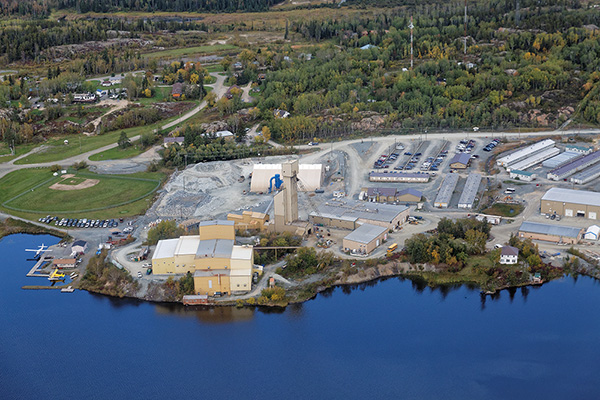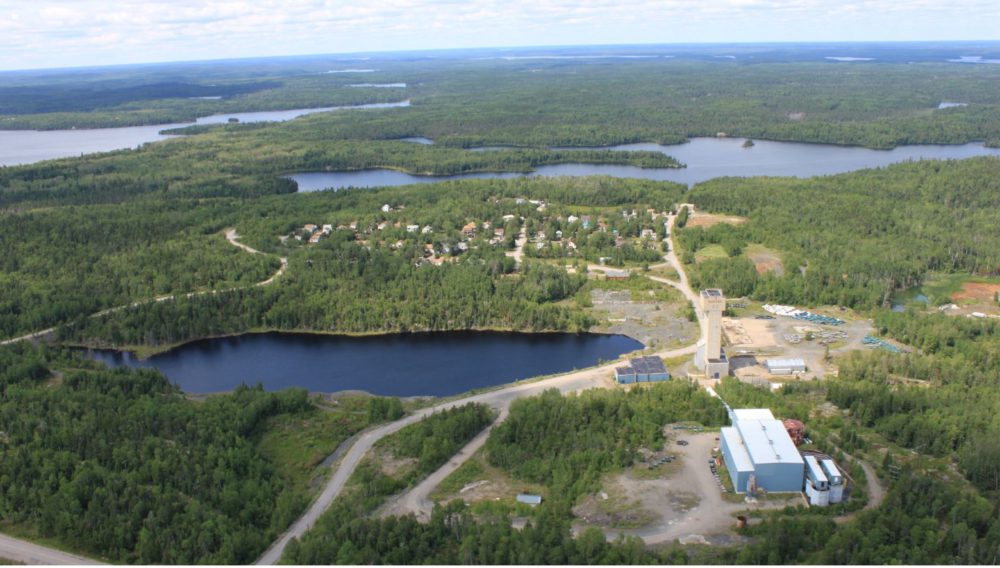Q&A with Ontario’s Mines Minister Michael Gravelle

Ontario’s Minister of Mines Michael Gravelle at the Lac des Iles pit.
With a provincial election coming up in June, we asked Michael Gravelle, Ontario’s minister of Northern Development and Mines to sit down with CMJ at the end of January.
Gravelle, a six-term Liberal MPP who has been a cabinet minister since 2007, and recently announced he’ll be running for re-election again, discussed resource revenue sharing with Aboriginal communities and his government’s eight-year effort to modernize Ontario’s Mining Act. He also provided an update on the government’s $1-billion commitment to bringing road access to the Ring of Fire – which was initially promised in 2014.
Canadian Mining Journal: Judging from the number of recent mining M&A deals involving projects in Ontario, mining companies clearly see the province as a favourable jurisdiction for developing and operating mines. But the exploration side of the industry is still struggling to raise capital. What is the province doing to assist juniors to make more discoveries in Ontario?
Michael Gravelle: While we’re very proud of the fact that we have over 40 operating mines in Ontario and 25,000 people directly employed, 50,000 indirectly employed, it’s really the juniors that find the discoveries that lead to new mines in the future. So we do need to support them. They have gone through some challenging times.
One program we put in place recently was a $5-million commitment towards the Junior Exploration Assistance Program (JEAP) to provide financial support to junior companies with project-specific costs related to exploration carried out in Ontario.
That program is funded by the Northern Ontario Heritage Fund Corp. and is administered by the Ontario Prospectors Association.
To date, the NOHFC has committed more than $2.5 million to 43 exploration projects under this program. We know it’s made a big difference to the companies that have been supported in terms of keeping companies open and allowing them to move forward with exploration activities. We want to continue to support them through the next tranche of the JEAP funding, which closed on Dec. 15. JEAP is a one-time program, but it’s been a real success and I’m keen to see it be renewed. I’m meeting with the NOHFC to discuss that in the near future.
We also market the provincial mining industry at the global industry trade and investment shows. That’s an opportunity for our ministry staff to invite investors to meet with junior exploration companies and other industry stakeholders.
Other support we provide them through the Ontario Geological Survey, which of course is an internationally recognized leader in the collection and dissemination of geoscience information.
Thee OGS is also known for producing quality open data sets, a foundational geological information resource used by the industry to select mineral exploration targets.
We’re optimistic about the future in terms of exploration.
Junior mining companies appear to have been more active over the past year as the result of a greater availability of financing. Of course, the Toronto Stock Exchange Venture is a key source of financing for Ontario’s junior miners. In 2017, $3.2 billion was raised in new equity capital for junior mining on the exchange, which was up 27% from $2.6 billion raised in 2016.
CMJ: There have been a lot of mineral discoveries in the Ring of Fire, but without infrastructure, new mines can’t be built in that area. Last year, the government announced it was moving ahead with two specific proposals for road access into that area. Can you update us on any progress that’s been made since then?
MG: Yes, we certainly understand that the key to opening up the Ring of Fire is infrastructure, which is why we are so pleased to be supporting three First Nations within the Matawa First Nations, who are working within their communities to develop all-season access roads through their communities to the provincial highway network and into the Ring of Fire.
Webequie and Nibiminik First Nation are working together on a potential east-west line through their communities, that work is ongoing, they are in consultation with their communities. We also have a project with Marten Falls First Nation, they are very keen to move forward with their community road leading to the provincial highway network near Aaroland and Greenstone, which would lead to a potential north-south road leading to the Ring of Fire.
This is a project we are strongly supporting, we’re working closely with all three communities as we are continuing to work with the Matawa First Nations on the Regional Framework Agreement which was put in place in March 2014 to focus on areas such as regional infrastructure development, socioeconomic supports, resource revenue sharing and enhanced environmental monitoring.
It’s important to understand the Ring of Fire is a major resource development project in a part of the province that’s never seen development before, and we are keen to make sure that we get it right. That’s why working with the First Nations, as it’s on their traditional territories, is so vital. These are First Nation proponent driven projects and it’s important they bring forward the environmental assessment proposal and we hope that will be happening soon.
CMJ: So the EAs haven’t started yet.
MG: No, no yet.
CMJ: Not all the First Nations communities in the Ring of Fire are supportive of the road proposals – how are you working to resolve that?
MG: We’re working through the Regional Framework Agreement. We want to make sure that there’s a strong recognition that in order for this project to move forward, we need to work with all the communities. Each of the communities is a different stage and the pace may be different in different communities, but we are working very happily with those communities that are prepared to work with us. Those that are more reluctant and are still pushing for other priority issues, we want to continue to work with them as well.
It’s important to recognize that Ontario has contributed significant dollars – over $114 million, including $44 million directly from our ministry – to First Nations and to tribal councils to support areas such as community readiness, capacity building, planning activities and access to technical expertise that will help them prepare for Ring of Fire development opportunities.
To date, over 3,100 First Nations clients have completed various training programs to support successful employment.
We continue to maintain an open dialogue with those First Nations in the region to ensure those communities can also participate in the decision making progress, because this is their decision.
CMJ: When the funding announcement was made last summer, road construction was expected to begin in 2019 – is that still the expectation?
MG: We’re moving forward as quickly as we can. Marten Falls in particular are keen to move forward with their all-season road and are close to putting forward their environmental assessment project proposal to both the federal and provincial governments. That project will be moving forward quickly.
With Webequie and Nibiminik, they’re doing a bit more work but we’re trying to keep on schedule. We’re keen to see this moving forward. That’s why we committed $1 billion to the Ring of Fire infrastructure. We made a case for the fact that in order to open up the Ring of Fire we need to have all-season access, and the best way to do that is by working through the communities that are most directly impacted by development.
CMJ: Since 2009, the government has been working to modernize the Ontario Mining Act. You’re now on Phase 3 – what are the latest changes coming for mining companies?
MG: We’re moving to an online mining claim registration system and electronic mining lands administration system, which will provide 24-hour, seven-day-a-week, real-time, self-serve access to mining claim registration. Over the past four years we’ve been consulting with the mineral industry and it prepare for the transition. The new mineral land administration system will officially be launched on Apr. 10. But there’s no question, this is about us catching up to other jurisdictions that have moved to online claims staking.
CMJ: The government provided some guidelines about the expectations and requirements for Aboriginal consultation in the first phase of the modernization. Do you have any indication that this has helped to reduce conflict and improve communication between the industry and communities?
MG: I think it will increase communication between industry and communities. Through these changes to the mining act, we have indeed introduced new rules and tools that provide clarity and certainty to industry to help build positive relationships with surface rights owners, and ensure consultation with affected Indigenous communities. Now, when a mining claim is put in place electronically, Indigenous communities can be informed immediately, in real time. This is important for us to do, being consistent with the recognition and affirmation of existing Aboriginal and treaty rights, and also being respectful of private land owners. We’ve advanced the process of consultation for Indigenous communities, which is one of the first parts of the act that began in 2009 was to have in the preamble acknowledgement of Aboriginal land and treaty rights and that’s been an important barometer of our work ever since then.
We are working on a new process to increase engagement and consultation for advanced exploration and mine production. This will involve ministry staff and community members participating in a joint review process with industry on large new or existing projects, and this process will begin when an applicable mine closure plan is received by the ministry for advance information.
CMJ: Capacity building for Aboriginal communities to engage in consultation remains an issue. You talked a bit about how you’re helping Ring of Fire communities build capacity; is there anything you’re doing on a wider basis for Aboriginal communities?
MG: We believe the path to reconciliation is through strengthening relationships with Indigenous people, including socioeconomic development. These relationships need to be built on meaningful partnerships, and the vision that Indigenous people themselves have for their futures. So we continue to work with Indigenous leaders on the broader benefits from resource development which may include capacity building measures.
We have an Aboriginal Participation Fund (APF), which supports consultation capacity, education and relationship building as it relates to mineral exploration and development. Through the APF, the ministry is helping to foster new opportunities to build and strengthen relationships among Indigenous community organizations, and government and industry, so we are quite excited about the work we’ve been doing in that regard, and the funding we’ve been able to provide to prepare communities – not only for the Ring of Fire, but for other mining developments across the province. The mining industry is the largest private sector employer of Indigenous people across the country.
We want to make sure that that is as much in partnership as possible, and that’s the work that we’re doing with both industry and Indigenous leadership.
CMJ: What is your government’s take on resource revenue sharing with Aboriginal communities?
MG: We are committed to working with Indigenous communities to ensure they can participate in and benefit from economic opportunities in resource related sectors. In May 2016, the government released the document The Journey Together: Ontario’s Commitment to Reconciliation with Indigenous Peoples, which will see Ontario working with Indigenous partners to address the legacy of residential schools, close gaps and remove barriers, support Indigenous culture, and reconcile relationships with Indigenous people. And this includes a commitment to engage with Indigenous partners on approaches to enhance participation in the resource sector by improving the way resource benefits are shared.
As part of that commitment in 2016, Ontario undertook exploratory discussions with First Nations organizations to discuss potential resource sharing principles, models and proposed approaches for future engagement in the forestry and the mining sector. So we are in the midst of a new phase of engagement with First Nations partners to discuss key parameters of potential resource revenue sharing frameworks and we’re very glad to be working with the Ministry of Natural Resources and Forestry and the Minister of Indigenous Relations to move this important file forward.
CMJ: The issue of resource revenue sharing has been something that Aboriginal communities have been asking for a long time. Is there a reason it wasn’t introduced as part of the modernization of the Ontario Mining Act?
MG: We felt the issue was a larger piece of the relationship between our government and the First Nations and we decided to bring it together by putting together the document The Journey Together. That’s the way that we worked with the First Nations and we will continue to do that.
CMJ: The modernization of the Mining Act is almost complete.
Assuming that the Liberals are re-elected this summer, can we expect anything new from you on the mining file?
MG: We’re going to continue to look for ways to improve investment in the mining sector in the province, that’s something we think about every single day. The modernization of the Mining Act has been an important part of us making the mining industry in Ontario more attractive and we’ll continue to work closely with the Ontario mining industry with our Indigenous partners on other opportunities.
Of course, there’s a thing called an election in the middle of all this, so we’ll have to see how things go, but we’ve worked hard to engage in partnership with Indigenous communities and the mining sector itself.





Comments
Chris
Looks like Ford will be the one who delivers on the Ring.
“Getting it right” didn’t work. They will now be voted out and someone else will move ahead with it.